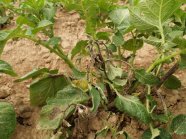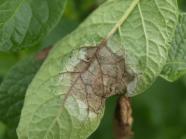
Control of Late Blight in Organic Farming
Late blight caused by the pathogen Phytophthora infestans is regarded as one of the most important diseases in potato production worldwide. In organic farming this pathogen is still an unresolved problem and can cause significant losses in crop yield and quality.
In conventional agriculture effective measures are available such as e.g. prognosis models and numerous fungicides. But in organic agriculture, at the moment, an infestation can only be controlled with plant protection products containing copper, as other alternatives are not available at present. These measures prove to be insufficient to effectively control late blight in years with high infestation pressure.
 Zoombild vorhanden
Zoombild vorhanden
Potato plant infested with stem blight
Therefore, the Institute for Plant Protection in Freising started a research project to develop, test and put into operation the prognosis model ÖKO-SIMPHYT for the control of late blight specifically in organic farming. The members of the research project include the Federal Research Centre for Cultivated Plants (JKI) in Braunschweig, the Central Institution for Decision Support in Crop Protection (ZEPP) in Bad Kreuznach, the producer association Bioland in Bavaria, the Ökoring Lower Saxony, plant protection services of the federal states and the German Weather Service (DWD). Further advice will be provided by specialists in organic farming with extensive practical experience, working in research or in consulting service and by Agroscope Rechenholz in Zurich participating as advisory team. The project is financed by the Federal Ministry of Food, Agriculture and Consumer Protection within the Federal Organic Farming Scheme.
Aim: minimise amount of copper used
Main Aim of this research project is to limit the application of fungicides containing copper to a necessary minimum considering the course of the epidemic and weather data. The project takes three different approaches:
- Reduction of primary stem infestation by treating seed tubers
- Development of a fungicide strategy to control infestation of leaves
- Development, testing and launching of the prognosis model ÖKO-SIMPHYT
Especially in organic potato production primary infestation (stem blight) causes problems as it is difficult to control using copper treatments and it can easily lead to an early beginning of leaf blight. One aim of the project is to develop strategies to control primary stem blight. For this purpose seed tubers will be treated with products containing copper in order to cut off the chain of infection between the latently infected tuber and the outbreak of early stem blight. If early infestation can be reduced considerably by treating seed tubers the epidemic is likely to start later and take a slighter course. The later the epidemic begins the fewer treatments are necessary.
To control secondary infections (leaf blight) fungicide strategies will be developed which define necessary application rates of copper considering infection pressure, application date and weather conditions. This will be achieved through the use of the prognosis model ÖKO-SIMPHYT which allows to predict the start of spraying and the successive applications. In the model the intervals between applications are calculated depending on infection pressure and weather conditions, so that in future fixed application dates such as weekly routine sprayings can be given up. In Germany the associations for organic farming “Naturland” and “Bioland” allow copper products with an application rate of maximal 3kg/ha of pure copper. Using the prognosis model ÖKO-SIMPHYT it should be possible to variably adjust application rates in order to achieve a maximum effect with as little copper as possible. Different copper formulations and application rates are being tested, as well as different varieties and methods of presprouting tubers.
Based on experimental results on primary and secondary infections from 2005 a working model of ÖKO-SYMPHYT was developed at the Central Institution for Decision Support Systems in Crop Protection (ZEPP). For this purpose the prognosis model SIMPHYT was modified and adjusted to the conditions in organic potato production. This working model will be tested nationwide for the first time in 2006 in collaboration with consulting services and Plant Protection Services of the federal states.
Situation of late blight in 2005
 Zoombild vorhanden
Zoombild vorhanden
Sporulating leaf blight
2005 was not a typical year for Phytophthora. Although in Bavaria spring 2005 was very wet at times and water dammed up between potato hills, before row closure stem blight occurred only rarely. The reason, most likely, was cold weather, especially night-time temperatures which often dropped below 10°C. Moreover, because of unfavourable conditions for emergence a large part of latently infested seed tubers, probably already, rotted in the soil. Due to cool weather in summer secondary infestation also did not cause problems in many places in Bavaria.
Treatment of seed tubers
In the first year of the project promising results were attained despite low infection pressure. By treating seed tubers with a copper containing product it was possible to reduce stem infestation as well as resulting secondary infestation of the leaves (fig. 1+2). Treatment of the tubers reduced primary infection distinctly, also reduced the following epidemic and delayed its beginning. After heavy rainfall and with high soil humidity Phytophthora infestans can either grow from the infested tuber upwards into the stem or sporulate on the seed tuber. Presumably the copper treatment did not affect the fungus growing from the diseased tuber into the stem. More likely the sporulation on the seed tuber was prevented or reduced respectively, thus considerably reducing further distribution of zoospores via soil water to neighbouring plants. At the sites Puch and Strassmoos Phytophthora infestans could already be detected by PCR tests a few days later emergence in potato stems although visible infestation did not occur until two weeks later. Positive PCR tests were often linked to rainfall. Analyses and field studies over the past years showed that the amount of rainfall and soil moisture can be decisive factors for the occurrence of stem blight. If between emergence and row closure strong rainfall occurs and the field is not accessible for tractors for more than three days, stem symptoms are most likely to occur 10-14 days later. Because of the increased capacity of the soil to retain water potatoes grown on loamy soils are considerably more endangered than crops on lighter soils.
Use of copper
In 2005 all variants of fungicide applications reduced late blight infestation (fig. 3). While SIMPHYT 1 defined the 4th of July as the start of spraying, infections on leaves did not show until the 19th of July. The variant with Cuprozin fl. 4 x 750g/ha achieved the best results in reducing infestation although the last application dated back 14 days. Because of the relatively low infestation rate there were only minor differences between the variants.
The first year of field experiments showed that treatment of seed tubers and spraying schemes with copper containing products adapted to infection pressure were able to reduce late blight in organic potato production. Within the next years the weather related evaluation of epidemics in ÖKO-SIMPHYT will further optimize the measures carried out. The aim is to provide the prognosis model ÖKO-SIMPHYT to those working in this field at the beginning of 2008.
The first year of field experiments showed that treatment of seed tubers and spraying schemes with copper containing products adapted to infection pressure were able to reduce late blight in organic potato production. Within the next years the weather related evaluation of epidemics in ÖKO-SIMPHYT will further optimize the measures carried out. The aim is to provide the prognosis model ÖKO-SIMPHYT to those working in this field at the beginning of 2008.





